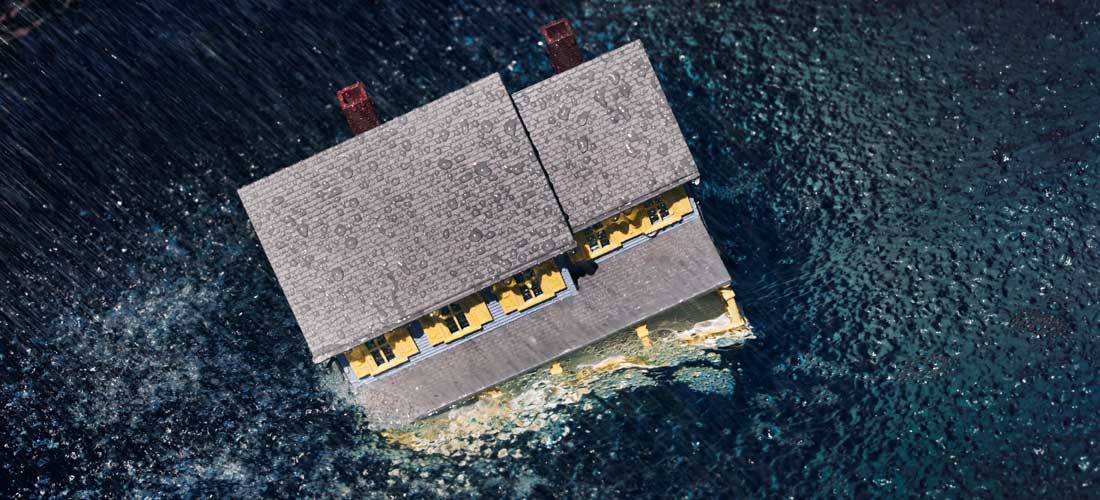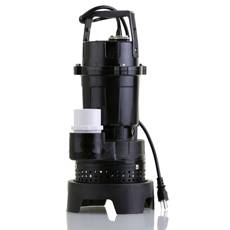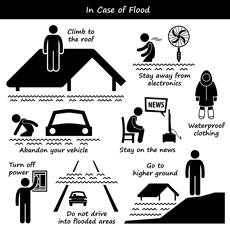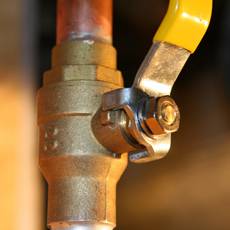Making sure you protect your home from flood damage could be the most important decision you make all year.
Many people think that standard homeowners and renters insurance cover flood damage, but it doesn’t. In fact, a separate flood insurance policy is needed. It is surprising to know that only 13 percent of U.S. homeowners have flood insurance policies even though it usually costs around $600 a year.

Protecting your home from flooding is important even if you don’t live near water. Even if you haven't experienced a flood in the past, it doesn't mean you won't in the future. Almost 20 percent of all flood claims, according to the National Flood Insurance Program, come from low to moderate risk areas for flooding. Excessive rain, fast melting snow and extreme weather conditions can put your home at risk. Consider these 5 ways to protect your home from flooding.
1. Get flood insurance
 A standard homeowners and renters insurance can cover damage and losses if water comes through a hole in the roof and or from wind-driven rain. But only flood insurance can save you from huge home repair costs caused by water from torrential rainfall, storm-swollen river, and other flood-inducing conditions. This is particularly important if your property is prone to damage caused by sewer backup as a direct result of flooding.
A standard homeowners and renters insurance can cover damage and losses if water comes through a hole in the roof and or from wind-driven rain. But only flood insurance can save you from huge home repair costs caused by water from torrential rainfall, storm-swollen river, and other flood-inducing conditions. This is particularly important if your property is prone to damage caused by sewer backup as a direct result of flooding.
Typically, there's a 30-day waiting period from date of purchase so don’t wait until an extreme storm is approaching to act. You can assess your risk for flooding and water damage using USAA’s Property Risk Assessment Tool.
2. Install a sump pump
 Protect your home against encroaching water by installing a sump pump. As your first line of defense, it is a smart thing to do to help remove water from your home and lessen the potential for water damage.
Protect your home against encroaching water by installing a sump pump. As your first line of defense, it is a smart thing to do to help remove water from your home and lessen the potential for water damage.
Weigh the pros and cons of an electricity-powered sump pump and a water-powered sump pump. But if you don’t want to take chances during prolonged periods of rain and flooding, especially when the power goes out, a water-powered sump pump is your best bet. No need for electrical power, battery or moving parts – just water from your area or a well – and it will remain operational.
3. Invest in flood sensors
 Sometimes, even the most careful routine maintenance and detailed annual plumbing inspection cannot prevent the appearance of that unannounced, unwelcome and potentially very expensive flooding. That’s why it is necessary to integrate flood sensors into your home security system. It is a proactive approach so you can quickly respond to a flood, as well as notify you of any other potential water-damaging events, such as an overflowing sink or a broken pipe.
Sometimes, even the most careful routine maintenance and detailed annual plumbing inspection cannot prevent the appearance of that unannounced, unwelcome and potentially very expensive flooding. That’s why it is necessary to integrate flood sensors into your home security system. It is a proactive approach so you can quickly respond to a flood, as well as notify you of any other potential water-damaging events, such as an overflowing sink or a broken pipe.
4. Create an emergency flood plan
 An emergency flood plan is a combination of practical and advance methods put together to afford you extra critical time when a flood is coming. Plan and practice a flood escape plan with your family so everyone will know what to do or how to respond calmly but in the quickest way possible when the water rises.
An emergency flood plan is a combination of practical and advance methods put together to afford you extra critical time when a flood is coming. Plan and practice a flood escape plan with your family so everyone will know what to do or how to respond calmly but in the quickest way possible when the water rises.
An emergency flood plan should include evacuation orders, knowledge on first aid supplies and/or emergency kit, as well as flood-proofing options at home. It should also help your children be aware of the dangers of fast-moving water plus tips to remember when they are stranded on the streets or when travel is no longer safe.
5. Install an automated shutoff valve
 An automated shutoff valve monitors water flow. As soon as the flood sensors are activated, it shuts off the main water supply. Look for a strategic location preferably near the primary water inlet in your house where you can install one.
An automated shutoff valve monitors water flow. As soon as the flood sensors are activated, it shuts off the main water supply. Look for a strategic location preferably near the primary water inlet in your house where you can install one.
Having an automated shutoff valve at home means that you can save your interiors from being reached by the flooding water, or that you need not worry about small leaking appliances while you are at work on a vacation. Most importantly, there are special seismic shut-off valves that can shut down the water flow if the plumbing breaks during a large quake. Like the flood sensors, an automated shutoff valve can be integrated with most home security and home automation systems.
Conclusion
You may not be able to stop an oncoming flood, but you may be able to mitigate the damages it can bring to your family. It is never too early to prepare, make changes, and take preventive steps so you can protect your home from flooding.













Write a Comment